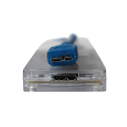USB Power Delivery Tester
For troubleshooting USB ports and USB chargers
- Test the power delivery capability of USB ports, Thunderbolt ports, USB chargers, and USB power banks.
- Check if a USB host is capable of delivering its maximum specified wattage without failing.
- Detect the wattage a USB charger (wall-wart) claims to support, which in turn controls the charging speed of mobile phones and other USB connected battery devices.
- Check that voltage levels remain within specification under high load.
- Measure the exact power usage of USB devices.
- Use it with the USB 3.0 Loopback Plug, to test communication speed, data integrity, and power delivery of USB ports simultaneously.
- QC4+ and PPS support available in model PM125.

Diagnose USB power
USB Power Delivery
Reviews
Safety Precautions
Do not touch or cover heatsink during operation as it can reach high temperatures, which could result in burns or failure of the USB PD Tester.
Do not block the operation of the fans & allow good airflow. Allow at least 10cm of air gap around the back of the fans. Also ensure there is airflow under the device.
Only use the USB PD tester with devices that claim compliance with the USB standards. A catastrophic failure of the device under test can result in the shorting of mains power to the USB cable. Which can both destroy the USB PD Tester and present a serious electrocution hazard.
The USB PD Tester is not a consumer device. It was designed for use by qualified electrical engineers.
Always have someone monitor the testing in case the device under test suddenly fails. Do not start a test and walk away.
Some USB power supplies are known to not fully comply with the USB standards. Some also do not comply with relevant electrical standards in the countries where they are sold. Faulty or poorly designed devices can be dangerous! The USB PD Tester may expose design and manufacturing flaws in the device when putting the device under high load. The result can be catastrophic failure of the device under test. Which in turn can lead to fire, melting of the device under test, smoke, electrical shorts and even destruction of the USB PD tester itself.
Do not draw more current from the device than it claims to support. The port might be damaged as a result, or over current protection might lead to the port shutting down.











